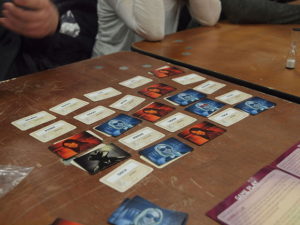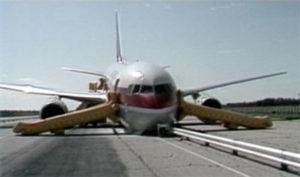This past Saturday I attended Atlanta Outworlders’ monthly Game Night.
One of my friends was on a team playing Codenames.
Codenames is a newish card-based game that’s become very popular. Nutshell, 25 cards are laid on the table in a grid, and based on a clue word and a number, teams have to choose cards, equal in quantity to the number, whose words relate somehow to the clue word.

I wasn’t playing this game, but I was sitting next to a friend. The opposing team was given the clue “Gimli” and the number “two.”
My friend leaned over to me and said in a stage whisper, big smile on his face, “I know which two cards they need to pick.”
One thing I know about this friend is that he’s a commercial aviation buff. He used to work for an airline, and his house is filled with memorabilia—shot glasses, antimacassars, souvenir pilot’s wings, and other knick-knacks, representing every major and many minor carriers operating all over the world over the past several decades. He even owns one of those carts that flight attendants push down the aisle for in-flight drink service.
I looked at the 25 cards. One of them read “PILOT” and another, “CRASH.” I realized my friend must be thinking about Air Canada Flight 143.
In July of 1983, Flight 143, a brand new Boeing 767 flying from Montreal to Edmonton, ran out of gas over Manitoba due to a one-in-a-million cascade of human errors and equipment malfunction. Both engines shut down, but in a truly heroic and thrilling display of derring-do, the pilots managed a dead-stick landing in Gimli, Manitoba, on the runway of a former RCAF base that had been converted into a drag strip. Although motorsports were happening on the ground and 69 souls were aboard the jet, not a single person died or was seriously injured.
The incident became known popularly as the “Gimli Glider.” If you’re an aviation nerd (or a sicko like me who reads up on shipwrecks and plane crashes), you’ve heard of it. Not many others have, though.
 I smiled back at my friend. Two of the other cards on the table bore the words “DWARF” and “RING.”
I smiled back at my friend. Two of the other cards on the table bore the words “DWARF” and “RING.”
“I know why you think you know the cards they want,” I told him, “But you’re wrong.”
I believe this story teaches some sort of lesson about making assumptions. My friend had 100 percent confidence that his guess was correct—and why wouldn’t he? The name “Gimli” is so specific and obscure. If, like my friend, you know about the Glider incident but haven’t read Tolkien, it would never enter your mind that Gimli could refer to anything other than the Glider. Or the reverse, if you’ve read Tolkien but don’t know about the Glider. We usually hedge our bets when we make guesses, but we love to go all in if we think something’s a lock. My friend had every reason to believe he was correct in his guess. But he wasn’t.
Which is not to say my friend didn’t screw up. His error was his failure to realize how few people know the Gimli Glider story.
Incidentally, the town of Gimli was settled by Icelandic immigrants to Canada in the 19th century. Icelanders are a Scandinavian/Nordic culture, and that’s the mythological tradition Tolkien drew on for his fantasy novels. So the similarity between the town’s and the dwarf’s names is surely not coincidental.
